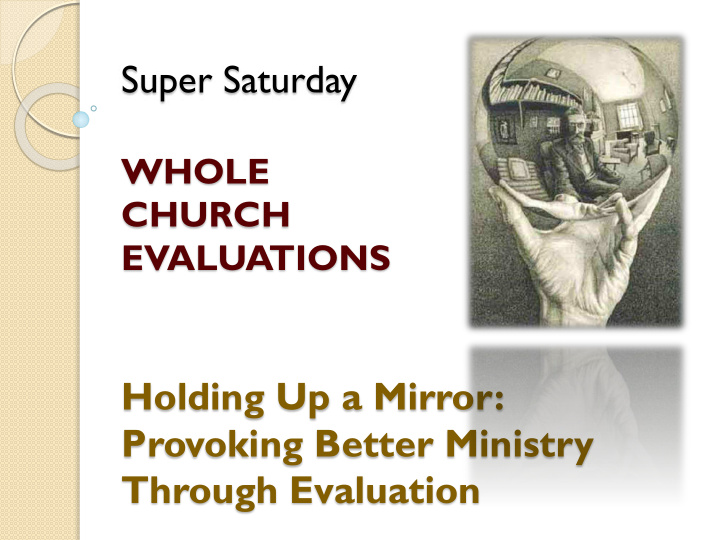



Super Saturday WHOLE CHURCH EVALUATIONS Holding Up a Mirror: Provoking Better Ministry Through Evaluation
“Holding Up a Mirror” Provoking Healthy Communication, Synergy, Alignment, AND
“Holding Up a Mirror” IT’S ABOUT BECOMING HEALTHY, FAITHFUL, EFFECTIVE
“Holding up a Mirror” Agenda Introductions & Checking I. Assumptions Who are you? o What evaluation(s) are you doing now? o II. Provoking Excellence through Whole Church Evaluation Theory and concepts o Consumer Mentality o T ypical Evaluations o Risks of the current models o
Holding up a Mirror Agenda III. Emerging Models for Ministry Evaluation More about hazards… o So why even do it? o What makes a good one? o Some emerging models… o IV. Resources V. Evaluation of today’s conversation
I. Introductions Checking Assumptions Evaluation in Your Church Let’s talk. In two sentences: o Name, Church o How are evaluations being done now? o Who is doing them and who is being evaluated?
II. Whole Church Evaluation What is your Business? How’s Business? PURPOSE
II. Whole Church Evaluation WHO IS YOUR CUSTOMER?
II. Whole Church Evaluation Some churches operate as though… The Pastor is the o performer The Congregation is o the audience God is the prompter o
II. Whole Church Evaluation What should it be? The Congregation is the performer o The Pastor is the prompter o God o is the audience
II. Whole Church Evaluation What should it be? CONGREGATION: Audience Performer GOD: Prompter Audience PASTOR: Performer Prompter
II. Whole Church Evaluation T wo typical types of church folks BIB APRON
INSTITUTIONAL MAINTENANCE VISION MANAGEMENT MONUMENT MUSEUM MOVEMENT MORGUE
What is your basis for evaluation FROM MANAGEMENT ◦ Building ◦ Budget ◦ Bylaws TO MISSION ◦ Vision ◦ Vitality ◦ Values
II. Whole Church Evaluation T ypical Current Evaluations: Survey Based o Anonymity an option o Scales and numeric ranking o Focused on pastor’s o performance and individual’s needs
II. Whole Church Evaluation Premises of current models: Pastor is our employee o We need to keep o everybody happy Pastor serves the needs o of the congregation
II. Whole Church Evaluation Risks with current models: Maintenance/Management o Divisive o Conflicting needs and o expectations Often Problem or Need based o Blaming and Shaming o No interaction for clarification o Performance based creates o tremendous potential for hurt – BURN OUT Encourages consumer mentality o
II. Whole Church Evaluation Premises of an alternative model: VISION CENTERED o Prayer centered o Servant centered o Whole-Church centered o The goal is to fine o tune and support tasks and mutually developed vision
III. Emerging Models for Ministry Evaluation What makes a good one? Has a framework that FOCUS ON VISION AND PURPOSE Mission/vision for whole congregation Defined roles and responsibilities Position descriptions Regular planning cycle with whole congregation Regular reports to governing body about progress towards goals Attention to providing staff and teams the resources necessary to do what is asked
III. Emerging Models for Ministry Evaluation What makes a good one? “The purpose of a ministry evaluation is to provide staff and laity, reliable feedback about how their work is going, so that they may strengthen the congregation’s ministry and mission.” It is about building up the 5:1 body of Christ
Whole Church Evaluation Handout
Visioning and Well Formed Outcomes " If you don't know where you are going , any road will get you there ." - Lewis Carroll " If you don't know where you are going , you might wind up someplace else ." -Yogi Berra " You've got to be very careful if you don't know where you're going, because you might not get there ."
VISIONING ASSESSMENT WHO ARE WE WHO IS OUR NEIGHBOR WHAT IS GOD CALLING US TO BE AND TO DO IN THIS TIME AND PLACE
ASSIGNMENT Determine WHO (laity, staff, committees, task teams, etc) is responsible for carrying out each goal, task and objective from the shared vision.
ALIGNMENT WHAT: Ensure that the resources of time, talent, training and treasures are distributed so that each one has what they need.
ADJUSTMENT MONITORING AND FEEDBACK MUSTANGS AND MULES Leadership meets together (possibly in a retreat setting) every 3 – 6 months to: Collaborate on progress Fine tune strategies Develop needed resources
Emerging Models for Ministry Evaluation One tool: “Marks of a Healthy Church”
Emerging Models for Ministry Evaluation One tool: “Completing the Circle”
Emerging Models for Ministry Evaluation One tool: “Spectrum Conversations tool ” The primary question is: “Are we being healthy, faithful and effective in this area?” PICK TOPIC or Category of church life, mission, purpose, vision Have members of the group LINE UP across an imaginary spectrum 1-9 ”1” being: “We are not showing any signs of having healthy, faithful and effective ministry in this area.” “9” being: “We don’t think we could make any improvement in this area.” TALK a) to your neighbors of the same opinion or b) to a group from somewhere else on the spectrum or c) count off and form small groups or d) whole group discussion.
Emerging Models for Ministry Evaluation QUESTIONS???
Recommend
More recommend